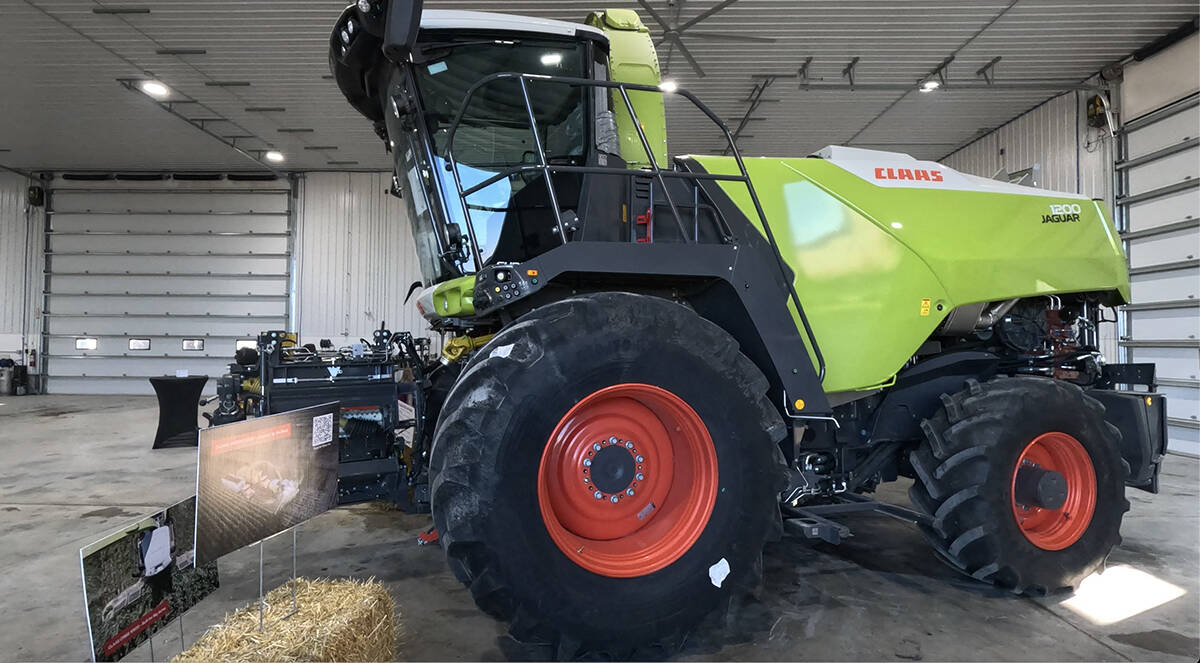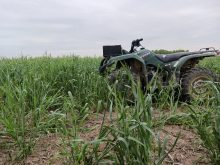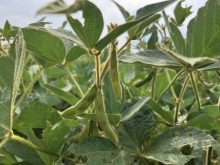A Brigden-area farmer’s field-to-field comparison during this year’s dry conditions for soybean planting supports the long-term benefit of no-till and cover crop strategies.
Aubrey Lang spoke about his family’s soybean-soybean-soybean-wheat rotation, with a rye cover crop almost yearly, during a grower open house hosted by Petrolia-based Field Farms Marketing on June 22.
Lang’s late grandfather bought one of the first no-till drills in Ontario in the 1980s, and the family continues to follow in his innovative footsteps while cropping about 2,500 workable acres.
Read Also

Claas brings 1000 Series SP forage harvesters to Canada
In mid-August, Claas unveiled its new line of Jaguar forage harvesters at an event in Visalia, California, deep in the heart of that state’s dairy region.
Why it matters: As Lang explained in a 2021 No-Till Farmer magazine article, a multitude of research shows that minimum tillage and cover crops benefit soil health and biodiversity.
The Langs have tried various options ranging from oilseed radish to oats since adding cover crops to their cropping toolbox. They now have approximately 95 per cent of their land with cover over the winter, either in the form of winter wheat or the rye crop they direct-seed into standing soybeans using a broadcast spreader just as the leaves begin to turn colour.
Typically, in the rotation, one field is left without cover over the winter because the Langs want one location that warms up and dries out early to start spring work without waiting for the soil under the rye to dry out.
Lang said sometimes they couldn’t even see the Amazone drill when planting beans in the spring because the rye cover could be 10-15 feet high. They spray the rye to kill it off before the beans emerge.
Lang told the FFM audience that this spring, as soybean seeding approached, he dug between two to three inches into the winter-bare field before finding moisture, whereas moisture was almost at the surface in the cover crop fields.
“This can be a detriment because it delays drying and warming in the spring,” he admitted. But it was a definite advantage this year, as evidenced by the high incidence of poor soybean germination across southwestern Ontario due to dry planting conditions.
There is typically a delay in germination compared to beans planted in bare soil, and “there are definitely risks involved because of the amount of residue with the rye,” Lang told the open house audience.
“The biggest challenge is getting the beans up.”
In a dry year, the rye can take up much of the moisture before they get into the field to plant the beans. Once the beans emerge, the rye residue “works as an ally with the beans” because it suppresses weeds and holds moisture by preventing evaporation.
To minimize crop loss and compaction, Lang uses a tramline system based on GPS where all the equipment — the spreader, the drill and the sprayer — has the same wheel spacings and follows the same paths in the fields.
Occasionally, less-than-favourable weather throws a curve in their seeding activities. If wet spring weather is getting late for soybean planting and the rye could soon head out, they spray it before and plant soybean through the residue.
In the fall, if dry weather causes poor germination in the rye planted prior to the soybean harvest, the rye is replanted with a drill after rain.
With the one year of wheat in the typical rotation, Lang explained, their “most expensive lesson” was leaving the wheat straw on the field to conserve nutrients.
“Slugs love cool, wet environments. If you don’t take off that wheat straw, it’s going to be a total slugfest because of all the residue,” Lang explained, adding the field was completely infested with slugs eating the pre-emerged soybean plants.
Even after replanting, there was still an almost complete crop loss. Now the Langs always harvest the wheat straw.
Several years into this rotation, Lang finds they “haven’t been putting a whole lot of nutrients into the soil over the years.”
Instead, they follow their agronomist’s recommendations and often opt for more seed-applied and foliar inoculants and innovative biological products than are typically used. Lang sees this as a more fossil fuel-efficient approach to boosting nutrient uptake than conventional fertilizers.
Lang believes the significant enhancement of soil biology and increased water-holding capacity from long-term no-till strategies allow crops to take better advantage of naturally occurring nutrient sources.
In addition, the Langs partnered with Ducks Unlimited and other conservation groups — through funding programs to preserve water quality in the Lake St. Clair watershed — to retire some of the gully bottoms and “protect ecosystems, create habitat and prevent erosion.”















